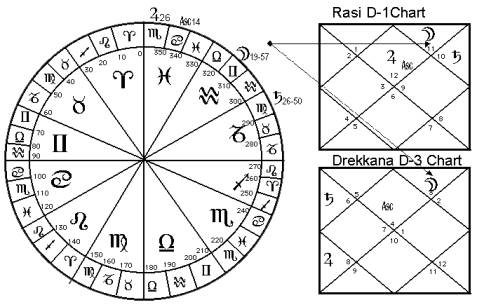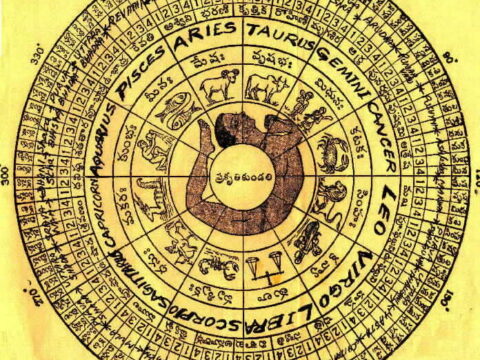Shankaracharya’s Prayer[1]
ॐ नारायण परोऽव्यक्तादण्डमव्यक्तसम्भवम्। अण्डस्यान्तस्तित्वमे लोकाः सप्तदीपा च मेदिनि॥
om nārāyaṇa paro’vyaktādaṇḍamavyaktasambhavam| aṇḍasyāntastitvame lokāḥ saptadīpā ca medini||
Translation: OM[2]: NARAYANA[3] IS BEYOND (MUCH ABOVE) THE UNMANIFEST[4]. THE BRAHMANDA[5] (COSMIC EGG) EVOLVES FROM THE UNMANIFEST. THE BRAHMANDA CONTAINS ALL THE WORLDS INCLUDING THIS EARTH WITH ITS SEVEN CONTINENTS.
This prayer of Adi Sankara has been taken from a smriti and gives the ultimate objective of every birth in this world at least. Thus, Sri Ramanujacharya has given the best mantra that will guide us to this
penultimate goal[6].

The Zodiac, called the Bha-Chakra symbolises the body of Narayana in it physical aspect or Brahmanda, as viewed from the earth at the centre. The Bha Chakra is divided into two signs starting from Aries and is called the 12-petal lotus of Brahma. Since the microcosm (Nara) is the same as the macrocosm (Narayana), the Bha Chakra also represents the individual (animate/inanimate object). Thus, eight latter mantra everything that we perceive at least, is represented by the zodiac. This twelve petal lotus grows from the navel of Narayana, and these points at 00 Aries, 00Leo and 00Sagittarius represent the Navel (also called Brahma Nabhi) and symbolise the end/beginning. Thus, these points are called Gandanta and the two Nakshetra-Pada adjoining each navel are called Gandanta-Pada. These are (a) 0-0′ to 3-20’ Aries and 26-40′ to 30-0′ Pisces around the point 0 Aries; (b) 0-0′ to 3-20’ Leo and 26-40′
to 30-0′ Cancer around the point 0 Leo & © 0-0′ to 3-20’ Sagittarius and 26-40′ to 30-0′ Scorpio around the point 00 Sagittarius. With this emerged the concept of perfect harmony or trines (and the angle of 120Deg). Thus, the zodiac was divided into three types of signs as movable and fixed and dual bodied.
The whole body of Narayana is divided into four parts called Brahma, Vishnu, Shiva and Vasudeva. These parts cannot really be differentiated from the whole and are complete in themselves like dividing infinity by four, we still get infinity as the result. Thus, Narayana with Sri Shakti is called Vishnu and is of pure Sattva Guna; Narayana with Bhoo Shakti is called Brahma and is of Rajas Guna; while Narayana with Kali Shakti was called Shiva and is of Tamas Guna. These three parts are full of nectar and are imperceptible. The fourth part of Narayana is called Vasudeva. This part is both perceptible (with three Shakti i.e. Sri-Shakti, Bhu-Shakti & Kali-Shakti and three guna’s intermingling) and imperceptible (with two Shakti’s- Sri-Shakti & Bhu-Shakti). As Vasudeva, Narayana sustains/maintains the Brahmanda. Thus, the zodiac when used for all material/purposes would represent Vasudeva[7] and the signs would Represent the three Gunas. All signs have all the three
gunas and only one dominates. Thus movable signs have a predominance of Rajas Guna, fixed signs of Tamas Guna and Dual signs of Satwa Guna. Because of the predominant Guna, the primary deities of the Dual, movable and fixed signs were Vishnu, Brahma and Shiva respectively. However, at a later date, to differentiate these deities from the pure parts of Narayana, the latter were also called Maha-Vishnu, Param-Brahma and Sada-Shiva.
Thus, in Vedic Astrology the perceptible part of Sri Vasudeva and the three deities Vishnu, Brahma and Shiva because very relevant, by providing the perception for guidance of the individual soul. Thus, the dasa system for timing events / guiding individuals and using the three types of signs is called Narayana dasa and its three types of Chara etc. dasa are specifically meant for movable / fixed / dual sign of the ascendant for the three deities Brahma / Shiva / Vishnu respectively.
Thus, the Narayana dasa gives the impact of the environment on the native while the Vimsottari dasa gives his reaction / experience. Without the Narayana dasa, we really cannot say the direction in which
the forces of nature and going to lead the native. The Vimsottari dasa, being an Udu dasa gives the state of mind / personal preparedness to deal with these directions.
Shakti literally means strength or power and specifically indicates the strength to achieve purpose. The purpose of Vishnu is to preserve the individual and Sri Shakti is his power to do the same. The strength of the lord of the second house will represent the strength of Sri Shakti and from the second lord Vishnu (or Hari Yoga) is ascertained. Thus, the second house deals with food / eating which is necessary for survival or sustenance as well as wealth for sustenance of everything. The lord of Lagna represents Bhoo Shakti and if strong with planets in quadrants, gives Brahma Yoga. Bhoo Shakti in one aspect is Savitur or Savitri whereby she provides the means for good health and long life and as Saraswati she provides the power of knowledge, speech and intelligence. Similarly the lord of the seventh house represents Kali Shakti and Hara Yoga occurs due to it. Hence the saying “Brahma gives longevity (Ayus), Vishnu gives wealth (Dhana) Shiva gives marriage etc (Kalyana)”. The Vimsottari dasa is used to judge the state of mind /self of the native, as it is also necessary to determine the availability of the means to achieve the purpose. The variation in Sri Shakti is examined from Su-dasa or Rasi dasa as it gives the level of prosperity while the variations in Bhoo Shakti (Savitri) is examined from Shoola dasa or any other Ayur dasa.
The Rasi, Navamsa (D-9) and Drekkana (D-3) are the most important divisional charts. Parasara explains that the Drekkana are ruled by Deva-Rishi Narada, Maha-Rishi Agasthya and Brahma-Rishi Doorvasha for dual / fixed / movable Drekkana respectively. Similarly fixed / dual / movable Navamsa are presided over by Shiva / Vishnu / Brahma respectively. Now for example if a planet is placed in Pisces in both
Rasi and Navamsa, it is stated to be Vargottama (i.e. having acquired the best division of the sign) and connects the Satwa Guna of the sign to Sri Vishnu the presiding deity of the Navamsa. The dasa system when we examine Guru Yoga, Mantra, Diksha and renunciation etc is called Drig dasa.
Hence, for a comprehensive examination of a chart the Narayana dasa, Su-dasa, Vimsottari dasa, Shoola dasa and Drig dasa should be examined.
FOOTNOTES
[1] Provided in the Bhagavad Gita with the commentary of Adi Sankara.
[2] OM is the cosmic syllable representing God
[3] Narayana is composed of two words ‘ Nara’ meaning ‘ any body ‘ and ‘ Ayana ‘ meaning ‘ Goal ‘. Thus the composite word Narayana means the ultimate goal of every body both living and non-living or mobile and immobile. In a more subtle sense it refers to the individual soul (Microcosm) endeavouring to attain Union (Yoga) with the Universal Soul (Macrocosm). Thus, Narayana also means this universal soul or supreme personality of Godhead.
[4] The Unmanifest is referred to as ‘Maya’ or illusion, and in the Bhagavad Gita is called the Akshara’ (syllable), immutable Brahma. Thus, if Narayana is said to be even above this sound syllable which is the
source of all creation, then Narayana is also Parambrahman or Sadasiva
[5] Brahmanda: Brahma, the dimurge God evolved from the navel of Narayana and ‘ Anda’ literally means the ‘egg. Thus Brahmanda refers to the hiranyagarbha (golden embryo – principle of cosmic evolution), whereby the universe was created. In fact ‘ All these worlds ‘ used in the prayer refers to the universe (’ Virat ‘) composed of five elements (or rather fire states of matter/energy). These are the earth elements (solid), water element (liquids), air element (gases). Fire element (energy) and space element (ether).
[6] (Vishnu Astakshari). “OM NAMO NARAYANAYA “.
[7] Hence, Vasudeva (or Krishna) shows the path for the individual soul to merge into Narayana. The mantra for this MOKSHA / NIRVANA / EMANCIPATION has been provided in the Madhusudana Stotra. It is called Sri Vishnu Dwadasakchari “ OM NAMO BHAGAVATE VASUDEVAYA.”












 DBC offers online courses in jyotish (Vedic Astrology) taught directly by Sanjay Rath as per the tradition, through narrated power points and other audio tools. The courses are at different levels, from the beginners through the intermediate to the advanced and are known as SoHamsa | DBC courses, with individual classrooms and assistant teachers
DBC offers online courses in jyotish (Vedic Astrology) taught directly by Sanjay Rath as per the tradition, through narrated power points and other audio tools. The courses are at different levels, from the beginners through the intermediate to the advanced and are known as SoHamsa | DBC courses, with individual classrooms and assistant teachers
 Sagittarius Publications is the publisher and distributor the popular quaterly magazine the Jyotish Digest, as well as many thorough books on the subject of Vedic Astrology or Jyotish.
Sagittarius Publications is the publisher and distributor the popular quaterly magazine the Jyotish Digest, as well as many thorough books on the subject of Vedic Astrology or Jyotish. We have an excellent pandit Divākar ‘Deva’ Mishra, who is from the priests of Vindhyāvāsini Siddha Pīṭha to guide you through the hundreds of temples of Kāśi [Varanasi] and neighbouring regions. He can organise your pūjā, keep you safe and take care. He is supported by an English-speaking well-travelled spouse ‘Supriya Mishra’. Please contact them directly for any services, remedial pūjā and tours. They handled the 60+ member Kāśi Jyotiṣa Group 2022.
We have an excellent pandit Divākar ‘Deva’ Mishra, who is from the priests of Vindhyāvāsini Siddha Pīṭha to guide you through the hundreds of temples of Kāśi [Varanasi] and neighbouring regions. He can organise your pūjā, keep you safe and take care. He is supported by an English-speaking well-travelled spouse ‘Supriya Mishra’. Please contact them directly for any services, remedial pūjā and tours. They handled the 60+ member Kāśi Jyotiṣa Group 2022.
amazing!